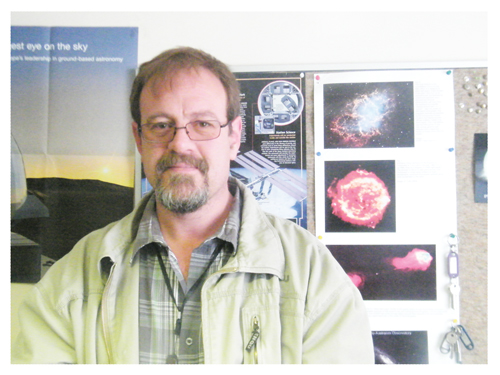
H.E.S.S II brings scientific benefits

Professor Riaan Steenkamp (Photograph by Hilma Hashange)
The new H.E.S.S II which came into operation on 26 July 2012 is the fifth telescope to be commissioned at Gamsberg, an area known for its excellent optical quality. It is considered to be the largest Cherenkov telescope ever built and is dedicated to observing the most violent and extreme phenomena of the universe in very high energy gamma rays. The other four telescopes went into operation in 2002 and were officially inaugurated in 2004. With its 28-metre size mirror and height of a 20 storey building when pointing up, the new telescope will be able to slew twice as fast as the smaller telescopes to immediately respond to fast and transient phenomena such as gamma ray bursts anywhere in the sky.
Today, well over one hundred cosmic sources of very high energy gamma rays are known. With H.E.S.S. II, processes in these objects can be investigated in superior detail. Anticipating many new sources, as well as new classes of sources, it will extend the energy coverage towards lower energies and further improve sensitivity. The telescope findings will also try to answer questions about the origin of the universe.
To date, the H.E.S.S. collaboration has published over 100 articles in high-impact scientific journals, including the top-ranked ‘Nature’ and ‘Science’ journals, with the first publication crediting Steenkamp and UNAM, appearing in the prestigious science publication, “Nature” in 2004. H.E.S.S. was awarded in 2006 the Descartes Prize of the European Commission, which is the highest recognition for collaborative research and in 2010 the prestigious Rossi Prize of the American Astronomical Society. In a survey in 2006, H.E.S.S. was ranked the 10th most influential observatory worldwide, joining the ranks with the Hubble Space Telescope or the telescopes of the European Southern Observatory ESO in Chile.
The telescope structure and its drive system were designed by engineers in Germany and South Africa, and produced in Namibia and Germany. The 875 hexagonal mirror facets which make up the huge reflector were manufactured in Armenia, and individually characterized in Germany. The mirror alignment system results from a cooperation of German and Polish institutes. The camera, with its integrated electronics, was designed and built in France. The construction of the new H.E.S.S. II telescope was driven and financed largely by German and French institutions, with significant contributions from Austria, Poland, South Africa and Sweden.








































